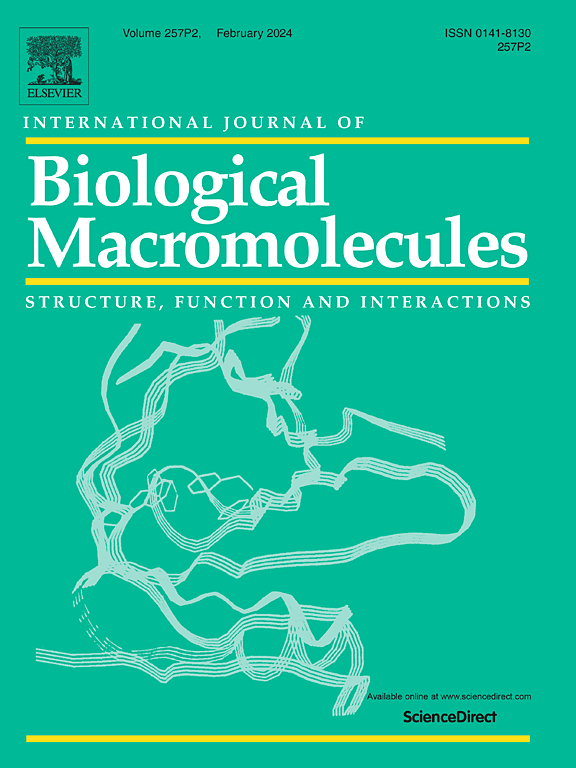Construction and characterization of a novel single-chain variable fragment against Bacillus thuringiensis vegetative insecticidal protein
IF 8.5
1区 化学
Q1 BIOCHEMISTRY & MOLECULAR BIOLOGY
International Journal of Biological Macromolecules
Pub Date : 2025-09-14
DOI:10.1016/j.ijbiomac.2025.147690
引用次数: 0
Abstract
Bacillus thuringiensis (Bt) vegetative insecticidal protein 3Aa (Vip3Aa) is widely used in transgenic crops to control Lepidopteran pests. Reliable detection methods are required for food safety or environmental monitoring. In this study, a single-chain variable fragment (scFv) gene was first constructed from a hybridoma cell line raised against Vip3Aa and cloned into the pET26b(+) vector. The functional scFv was expressed in Escherichia coli BL21(DE3) with a yield of 1.3 mg/L. Molecular docking revealed that scFv binds to the Vip3Aa interface via epitopes in Domains III and V, with two salt bridges and six key hydrogen bonds observed in the complex. A sandwich ELISA was subsequently established using the purified scFv as the detection antibody and anti-Vip3Aa pAbs as the capture antibody. The limit of detection (LOD) and limit of quantification (LOQ) were determined to be 0.12 and 0.50 μg/mL, respectively, with a working range of 0.50–10.00 μg/mL. The sandwich ELISA had no cross-reactivity to other commonly used insecticidal proteins (Cry1Ac, Cry1Ab, Cry1F, and Cry2Ab) in genetically modified (GM) crops. This scFv shows potential for GM crops detection and could reduce costs compared to monoclonal antibody-based detection methods; the antibody-binding information obtained in this study may also guide future antibody design.
一种抗苏云金芽孢杆菌营养杀虫蛋白单链可变片段的构建与鉴定。
苏云金芽孢杆菌(Bacillus thuringiensis, Bt)营养杀虫蛋白3Aa (Vip3Aa)被广泛应用于转基因作物中防治鳞翅目害虫。食品安全或环境监测需要可靠的检测方法。本研究首先从抗Vip3Aa的杂交瘤细胞系中构建单链可变片段(scFv)基因,并将其克隆到pET26b(+)载体中。功能scFv在大肠杆菌BL21(DE3)中表达,产率为1.3 mg/L。分子对接发现,scFv通过结构域III和V的表位与Vip3Aa界面结合,在配合物中观察到两个盐桥和六个关键氢键。随后以纯化的scFv为检测抗体,以抗vip3aa pab为捕获抗体,建立夹心ELISA。测定的检出限和定量限分别为0.12和0.50 μg/mL,工作范围为0.50 ~ 10.00 μg/mL。该夹心ELISA与转基因作物中常用的其他杀虫蛋白(Cry1Ac、Cry1Ab、Cry1F和Cry2Ab)无交叉反应性。与基于单克隆抗体的检测方法相比,该scFv显示了转基因作物检测的潜力,并且可以降低成本;本研究中获得的抗体结合信息也可以指导未来的抗体设计。
本文章由计算机程序翻译,如有差异,请以英文原文为准。
求助全文
约1分钟内获得全文
求助全文
来源期刊
CiteScore
13.70
自引率
9.80%
发文量
2728
审稿时长
64 days
期刊介绍:
The International Journal of Biological Macromolecules is a well-established international journal dedicated to research on the chemical and biological aspects of natural macromolecules. Focusing on proteins, macromolecular carbohydrates, glycoproteins, proteoglycans, lignins, biological poly-acids, and nucleic acids, the journal presents the latest findings in molecular structure, properties, biological activities, interactions, modifications, and functional properties. Papers must offer new and novel insights, encompassing related model systems, structural conformational studies, theoretical developments, and analytical techniques. Each paper is required to primarily focus on at least one named biological macromolecule, reflected in the title, abstract, and text.

 求助内容:
求助内容: 应助结果提醒方式:
应助结果提醒方式:


